
De belangrijkste wijzigingen op een rij


-ENGLISH BELOW-
Na de succesvolle herziening van de NEN 4400-1 in 2023, is nu ook de NEN 4400-2 geactualiseerd. Deze norm is bedoeld voor buitenlandse ondernemingen die personeel ter beschikking stellen of werk aannemen in Nederland. De herziene versie is gepubliceerd op 9 september 2025 en treedt in werking op 1 januari 2026.
De aanpassingen sluiten aan op de structuur en aanpak van de NEN 4400-1:2023 en omvatten onder andere:
De herziene norm is verkrijgbaar via de NEN: NEN 4400-2:2025 nl. In dit artikel zetten we de belangrijkste wijzigingen op een rij en geven we inzicht in wat je kunt verwachten tijdens inspecties. Zo zorgen we er samen voor dat jij goed voorbereid bent.
De norm NEN4400-2:2025 vormt samen met het SNA Handboek Normen het SNA schema. Het belangrijkste doel van de herziening is een meer risicogerichte aanpak van inspecties. Er is niet meer standaard een volledige inspectie met na zes maanden een verkorte inspectie. De volledige inspectie fungeert voortaan als nulmeting. Op basis van deze nulmeting wordt bepaald hoe de vervolginspectie eruitziet. De mate waarin een onderneming zijn administratie op orde heeft en eventuele risicogebieden bepalen de inhoud van de vervolginspectie. Zo kunnen inspecteurs een vervolginspectie dus gerichter insteken met zaken die voor jouw onderneming relevant zijn.
Afhankelijk van de uitkomsten van de nulmeting zijn er vier varianten van vervolginspecties. De lichtste variant, toetsing op alleen de module ‘Algemeen’, is mogelijk als:
In de tabel staat welke normonderdelen de module Algemeen bevat en waar je dus op getoetst wordt.
 Wat wijzigt er?
Wat wijzigt er?De norm is opgedeeld in drie modules:
Het in- en doorlenen van personeel en zzp’ers blijft onderdeel van de betreffende modules. Ondernemingen die zowel uitzenden (TBA) als werk aannemen worden gezien als mengbedrijven. Voor hen geldt toetsing op beide modules. De inhoudelijke eisen blijven grotendeels gelijk, waardoor organisaties die nu voldoen, naar verwachting ook aan de herziene norm voldoen. In de tabellen hieronder zie je op welke normonderdelen je per module getoetst wordt.
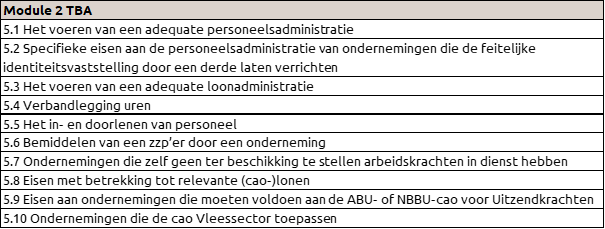
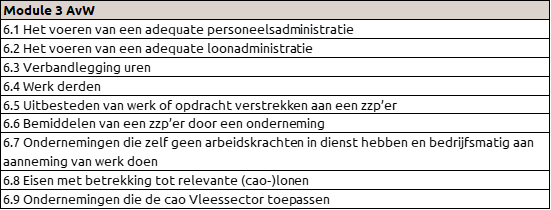
De aanwezigheid én werking van procedures worden expliciet onderdeel van de norm. Deze nemen wij dus mee in onze inspecties. Procedures moeten aantoonbaar aanwezig zijn – schriftelijk of geautomatiseerd – en effectief blijken uit inspecties en steekproeven. Als er non-conformiteiten worden vastgesteld, dan moet de inspecteur concluderen dat de procedure niet (volledig) werkt en daarmee niet (volledig) aanwezig is. In dat geval komt de onderneming niet meer in aanmerking voor een vervolginspectie van de lichtste variant. 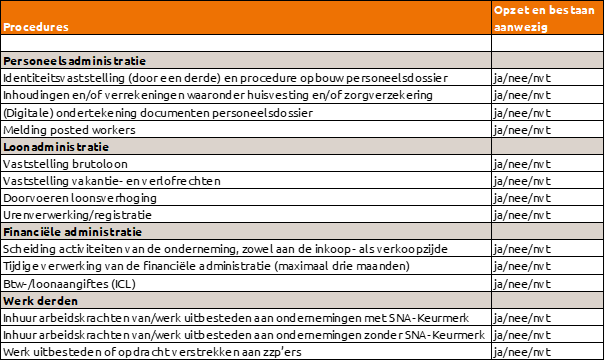
De herziene norm introduceert een nieuwe risicoanalyse. Uit deze nieuwe risicoanalyse volgt enkel nog of de onderneming in een hoog of laag risico valt. Een onderneming valt in het hoog risicoprofiel als 6 of meer van de onderstaande vragen met “ja” worden beantwoord:
De uitkomst van deze risicoanalyse bepaalt de steekproefomvang van de personeelsdossiers en lijncontroles.
Bij een laag risicoprofiel geldt een steekproef van 10. Bij een hoog risicoprofiel is dit 15. De verdeling van deze aantallen is als volgt:
Aantal steekproeven 10:
Aantal steekproeven 15:
De weging van non-conformiteiten is aangepast. Waar voorheen bij het aantreffen van één of meerdere fouten in de steekproef een uitbreiding van de steekproef verplicht was, is dat in de herziene norm losgelaten. De nieuwe steekproefaantallen zijn statistisch onderbouwd en representatief voor de totale populatie. Eén fout in de steekproef kan dus al voldoende zijn om conclusies te trekken over de volledigheid en betrouwbaarheid van de administratie.
Het uitgangspunt is dat herhaling van dezelfde fout binnen de steekproef wijst op een structureel probleem. In dat geval wordt de fout als structureel beoordeeld en als non-conformiteit geregistreerd, die binnen drie maanden hersteld moet worden volgens de 4-O systematiek. Twee of meer fouten op hetzelfde normelement, die in de ‘oude’ norm als major non-conformiteiten zijn aangemerkt, leiden tot een major non-conformiteit.
Meer over de 4-O systematiek lees je in onze gratis whitepaper.
Vanaf 1 januari 2026 worden alle volledige inspecties uitgevoerd volgens de herziene norm. Uit deze volledige inspecties volgt een vervolginspectie en geen verkorte inspectie.
Verkorte inspecties die vanaf 1 januari plaatsvinden kennen een overgangstermijn: ze worden nog getoetst op de oude norm (NEN 4400-2:2017), maar gerapporteerd en verwerkt volgens de nieuwe norm. De risicoanalyse van de herziene norm wordt al toegepast bij het bepalen van de steekproef.
Heb je vragen of wil je sparren over de impact van de nieuwe norm op jouw organisatie? Neem contact met ons op. We denken graag met je mee.
Following the successful revision of NEN 4400-1 in 2023, the NEN 4400-2 standard has now also been updated. This standard applies to foreign companies that provide personnel or carry out work in the Netherlands. The revised version was published on 9 September 2025 and will come into effect on 1 January 2026.
De aanpassingen sluiten aan op de structuur en aanpak van de NEN 4400-1:2023 en omvatten onder andere:
The revised standard is available via NEN: NEN 4400-2:2025 nl. This article outlines the key changes and provides insight into what to expect during inspections, so you can be well prepared.
Together with the SNA Handbook of Standards, NEN 4400-2:2025 forms the SNA scheme. The main objective of the revision is to introduce a more risk-based inspection approach. The standard no longer requires a full inspection followed by a shortened inspection six months later. Instead, the full inspection now serves as a baseline. Based on this baseline, the scope of the follow-up inspection is determined. The extent to which a company’s administration is in order, along with any identified risk areas, defines the content of the follow-up inspection. This allows inspectors to focus on matters that are relevant to your organisation.
Depending on the outcome of the baseline inspection, there are four types of follow-up inspections. The lightest version—assessment of the ‘General’ module only—is possible if:
The table outlines the standard components included in the General module and what you will be assessed on.

The revised standard is divided into three modules:
The hiring and subcontracting of personnel and self-employed workers remains part of the relevant modules. Companies that both provide labour and contract work are classified as mixed businesses and will be assessed on both modules. The substantive requirements remain largely unchanged, meaning organisations that currently comply are expected to continue to meet the revised standard.
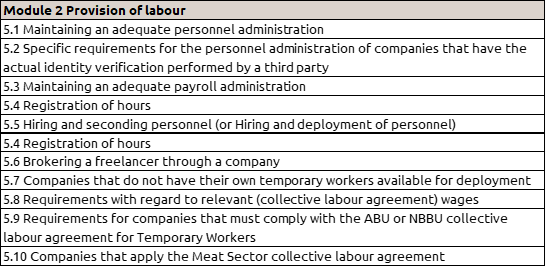
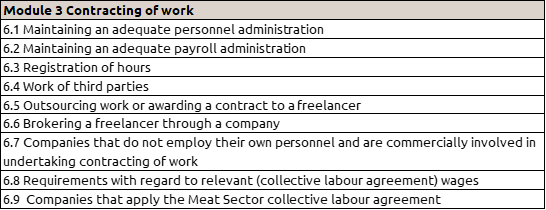
The presence and effectiveness of procedures are now explicitly part of the standard. These are included in our inspections. Procedures must be demonstrably present—either in writing or digitally—and must prove effective through inspections and sampling.
If non-conformities are identified, the inspector must conclude that the procedure is not (fully) functioning and therefore not (fully) present. In such cases, the company will no longer qualify for the lightest variant of the follow-up inspection.
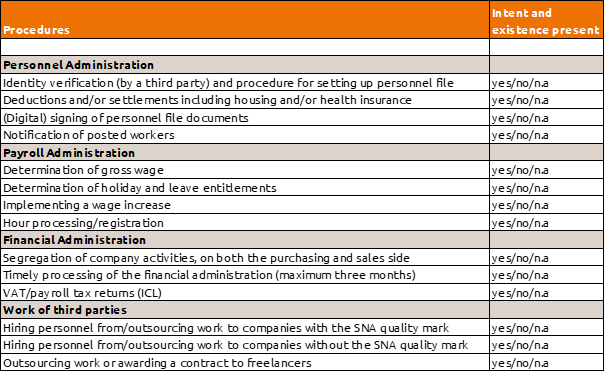
The revised standard introduces a new risk analysis. This analysis determines whether a company falls into a high or low risk category. A company is classified as high risk if six or more of the following questions are answered with “yes”:
The outcome of this risk analysis determines the sample size for personnel files and line checks.
For organisations with a low risk profile, a sample size of 10 applies. For those with a high risk profile, the sample size increases to 15. The breakdown of these sample sizes is as follows:
Sample size: 10
Sample size: 15
The assessment of non-conformities has been revised. Previously, one or more errors in the sample required an expanded sample. This is no longer the case. The new sample sizes are statistically substantiated and representative of the full population. A single error in the sample may already indicate issues with the completeness and reliability of the administration.
Repeated occurrence of the same error within the sample is considered a structural issue. In such cases, the error is recorded as a non-conformity, which must be resolved within three months using the 4-O methodology. Two or more errors on the same standard element—previously classified as major non-conformities—will still be considered major under the revised standard.
From 1 January 2026, all full inspections will be conducted according to the revised standard. These full inspections will lead to a follow-up inspection, rather than a shortened inspection.
Shortened inspections conducted from 1 January onwards will follow a transitional arrangement: they will still be assessed against the old standard (NEN 4400-2:2017), but reported and processed according to the revised standard. The risk analysis from the revised standard will already be used to determine the sample size.
Do you have questions or would you like to discuss how the revised standard may impact your organisation? Feel free to contact us. We’re happy to help.